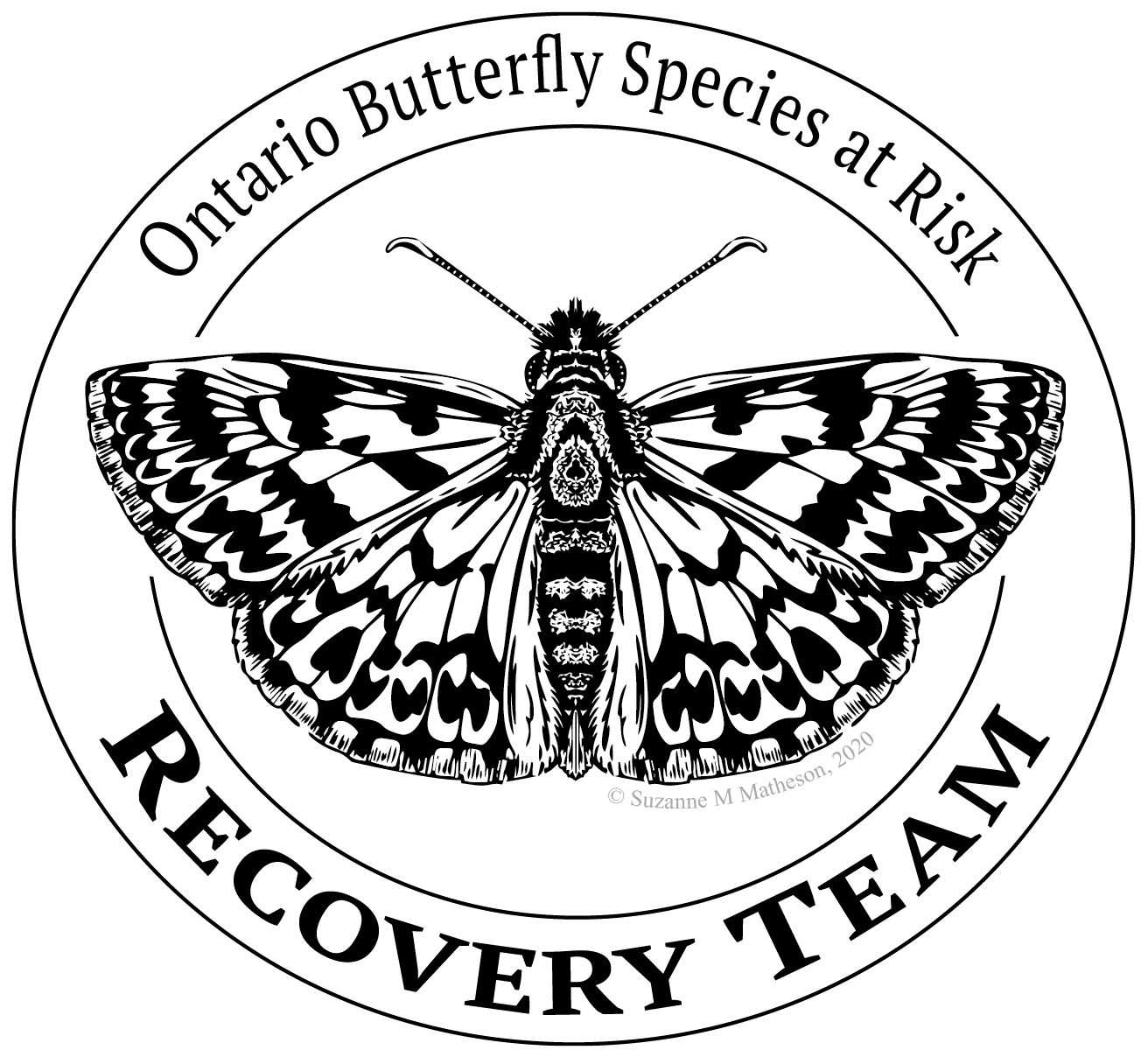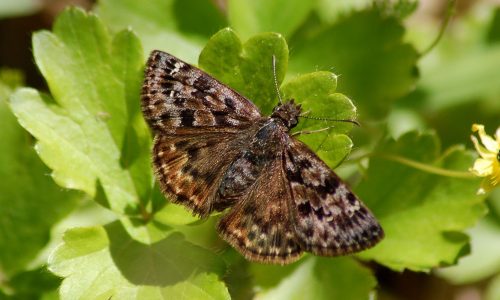
The Mottled Duskywing (Erynnis martialis) is a medium-sized dark spread-wing skipper butterfly with a very mottled appearance. Historically, Mottled Duskywing existed throughout the eastern and central United States and parts of south-central Canada (southeastern Manitoba, southern Ontario and southern Quebec). Severe population declines have been observed in many U.S. states and is thought to be extirpated from the province of Quebec (COSEWIC 2012). In southeastern Manitoba, populations are still present but also reported as declining.
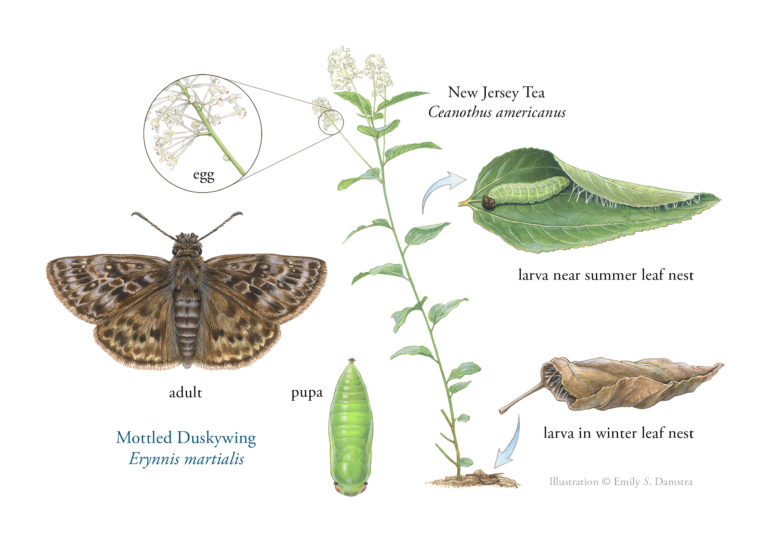
In Ontario, Mottled Duskywing occurs in small, isolated colonies where suitable habitat occurs. It was classified as endangered by the Committee on the Status of Endangered Wildlife in Canada (COSEWIC) in 2012 and in Ontario by the Committee on the Status of Species at Risk in Ontario (COSSARO) in 2013, affording it protection under the Endangered Species Act, 2007.
The Mottled Duskywing is not a migratory species, and therefore occupies its habitat throughout the year in its various life stages: egg, caterpillar (larva), chrysalis (pupa), and adult butterfly. It tends not to stray far from suitable habitat containing its larval food plants which are Prairie Redroot (Ceanothus herbaceus) and New Jersey Tea (C. americanus). These plant species prefer open or partially shaded areas maintained by periodic disturbance. Adult butterflies are active mating and laying eggs from mid-May to late June throughout most of their range, and in extreme southern Ontario, a second generation is on the wing from mid-July to late August. Caterpillars emerge from eggs only days after they are laid and feed on their host plants on which they form leaf nests sewed with silk. When they reach maturity, they either pupate (i.e., form a chrysalis) and emerge in a few weeks (where a second generation occurs) or they overwinter as a caterpillar until the following spring (Linton 2015).
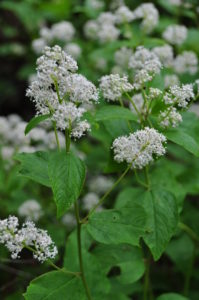
In Ontario the Mottled Duskywing is threatened by habitat destruction, habitat fragmentation, improper habitat management, deer browsing of host plants, and pesticide use. It formally occupied known sites of several other oak savanna specialist butterflies which are now extirpated from Canada including the Karner Blue, Eastern Persius Duskywing, and Frosted Elfin. Mottled Duskywing is Ontario’s only “endangered” species of butterfly and the province has produced a recovery strategy for the species (Linton, 2015). A large focus of the Recovery Team’s work is ensuring the Mottled Duskywing does not meet the same fate as other extirpated oak savanna butterflies.

Karner Blue (Lycaeides melissa samuelis) is a small, brilliant blue butterfly in the family Lycaenidae. Historically, Karner Blue was distributed across northeastern United States and southern Ontario. Over the last 100 years, its population size is estimated to have decreased by 99% over its global range. The most recent Canadian observations of the species were recorded in 1991 at two well-known locations: Port Franks/Pinery Provincial Park and St. Williams, Ontario. However, specimen records indicate it was also historically known from Toronto, London, and Sarnia. It was officially listed as extirpated from Ontario (and Canada) in 1997.
Karner Blue caterpillars feed exclusively on Wild Lupine (Lupinus perennis) which in Ontario is associated with open or semi-open vegetation communities found on sandy soils such as sand dunes, savanna, prairie, and dry oak woodlands. In addition to the presence of Wild Lupine, other important habitat characteristics include nectar resources, the presence of larval tending ants, and maintenance of a disturbance regime conducive to Wild Lupine persistence.
Adult Karner Blue have two flight periods in Ontario: from late May to late June and from mid-July to mid-August, with fewer individuals in the first generation than in the second (COSEWIC 2000). First generation females lay eggs on leaves and leaf petioles of Wild Lupine and the caterpillars that emerge feed on the leaves of the Wild Lupine. When mature, caterpillars pupate then emerge as a second generation of adult butterflies. Second generation females lay eggs low down on Wild Lupine plants and the eggs drop to the ground when leaves are shed in the autumn (Hess 1983). Eggs deposited by second generation females enter a period of diapause (a period of suspended development) and will overwinter until the following April (Jarvis 2014).
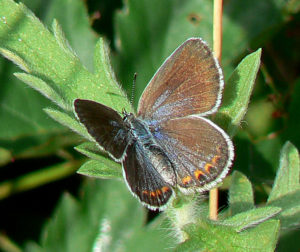
Historical and current threats to Karner Blue include direct habitat loss, habitat fragmentation, invasive and exotic species, inclement weather and climate change, recreational activities which destroy or damage habitat, and pesticide use. A combination of factors is thought to have reduced populations in Ontario below the threshold for viability and a severe drought wiped out the last remaining individuals . (Environment and Climate Change Canada 2017)
Given the similarities in habitat requirements and historically occupied locations, a joint Recovery Strategy for Karner Blue, Frosted Elfin, and Eastern Perisus Duskywing has been developed by the Canadian Wildlife Service which identifies research, habitat restoration and management, monitoring and education, and reintroduction needs.
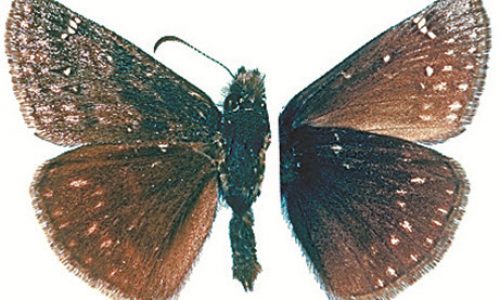
The Eastern Persius Duskywing (Erynnis persius persius) is a small brown skipper butterfly. It is extremely difficult to distinguish from the more commonly encountered Wild Indigo Duskywing (E. baptisiae) and Columbine Duskywing (E. lucilius). Canadian populations of Eastern Persius Duskywing are restricted to southwestern Ontario with the only two confirmed locations, St. Williams Conservation Reserve and near Pinery Provincial Park, being widely separated. It was last observed in 1987 despite concentrated efforts to find and it is likely that this species is extirpated from Canada (Need reference). However given the issues with accurate identification it is difficult to confirm with certainty. In Canada, Eastern Persius Duskywing is therefore listed as Endangered on Schedule 1 of the federal Species at Risk Act (SARA). Provincially the species is considered Extirpated and therefore listed as such under the province of Ontario’s Endangered Species Act.
The Eastern Persius Duskywing requires the persistence of Wild Lupine, which females lay eggs on and caterpillars feed on. It almost always occurs in savanna and prairie habitats with populations of Wild Lupine. Improper habitat management resulting decline of lupine populations and aerial pesticide application are thought to have contributed to its decline. Additional threats to Eastern Persius Duskywing include direct habitat loss, habitat fragmentation, invasive and exotic species, inclement weather and climate change, and recreational activities which destroy or damage habitat (Environment and Climate Change Canada 2017).
Given the similarities in habitat requirements and historically occupied locations, a joint Recovery Strategy for Karner Blue, Frosted Elfin, and Eastern Perisus Duskywing has been developed by the Canadian Wildlife Service which identifies research, habitat restoration and management, monitoring and education, and reintroduction needs.
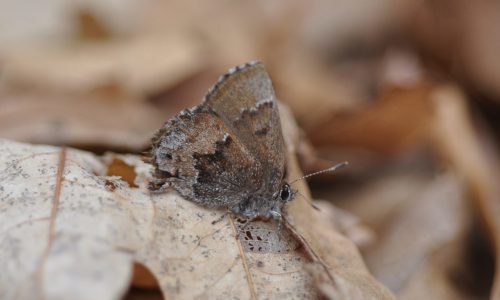
Frosted Elfin (Callophrys incisalia irus) is a small brown butterfly in the family Lycaenidae. In Canada has only been observed to feed on Wild Lupine (Lupinus perennis), particularly its flowers. The only known site for this species, where it was last observed in 1988, was near the St. Williams Conservation Reserve in Norfolk County, Ontario. In Canada it is listed as Extirpated on Schedule 1 of the federal Species at Risk Act (SARA). Provincially the species is also considered Extirpated and therefore listed as such under the province of Ontario’s Endangered Species Act.
Like other lupine-specialist butterflies, Frosted Elfin is dependent on Wild Lupine. In general, habitats which facilitate the persistence and flowering of Wild Lupine are rare in Ontario and are characterized by areas with sandy soils typically associated with sand dunes, savanna, prairie and dry oak woodlands where canopy cover is incomplete. The adult Frosted Elfin has one flight period in the spring, in May and early June (Packer 1991). Adult females lay eggs on the flower buds of Wild Lupine and larvae are generally present within two weeks of spring adult emergence (Schweitzer et al. 2011). During a period of approximately 3 months, larvae feed on lupine flower parts including the petals, stamens, pistils and carina and pass through 3 development stages (instars) (Cook 1906). Pupation occurs in leaf litter in a constructed silk shelter at the base of the plant or below the surface of the soil (COSEWIC 2000). The pupal stage is the longest stage in the life cycle of the species, lasting from late summer until the following spring. Adults may live two to three weeks based on flight time but it is unknown what the average lifespan is.
Historical and current threats to Frosted Elfin include improper habitat management, direct habitat loss, habitat fragmentation, invasive and exotic species, inclement weather and climate change, recreational activities which destroy or damage habitat, and pesticide use (Need reference for this paragraph).
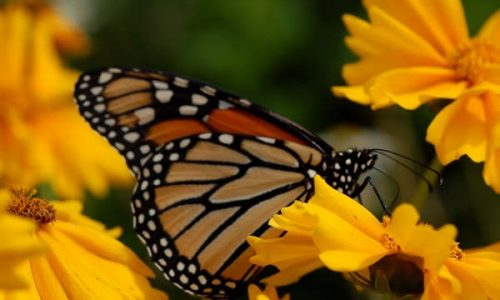
The Monarch (Danaus plexippus) is a large showy butterfly, distinctly known for its black, orange, and white colouration and its seasonal appearances in all Canadian provinces. Its diet is relatively limited, as it predominately feeds on Milkweeds (multiple species) during all stages of its development—from pupae to butterfly (COSEWIC, 2017). Considering the wide distribution of this plant in all provinces in Canada, the migration of the Monarch is also expansive; these butterflies migrate from southern Canada/northern United States to warmer locations such as Mexico or the American west coast in the fall, making return trips to the north in the spring COSEWIC, 2017) . In Canada, the butterfly is listed as a Species of Special Concern on Schedule 1 of the Species at Risk Act (SARA) and the Endangered Species Act.
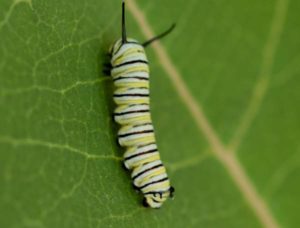
The habitat of this butterfly varies greatly, as its migration occurs across large parts of North America. In fact, Monarchs migrate up to 4,000 kilometers from Canada to Mexico , (Government of Canada 2019). Milkweed species (especially common milkweed) have adapted to many soil conditions (including disturbed soil) and can often be found grasslands, agricultural croplands, forests, and wet shorelines (CWF 2020).
Monarchs returning from Mexico lay eggs on milkweeds in Ontario. Over the summer they produce several generations of butterflies, going through their complete lifecycle of egg, caterpillar, pupa, adult. The fall generation of Monarchs are reproductively inactive and invest all their resources in making the journey to Mexico where they spend the winter in high altitude Oyamel Fir forests (Pérez-Miranda et. Al, 2020).
Monarch populations tend to fluctuate from year to year, however they have experienced an alarming downward trend in abundance the last two decades. The exact reasons for this are unknown, but are generally attributed to a combination of breeding habitat loss, climate change, deforestation in Mexico and, and agricultural practices (COSEWIC 2017).
In 2014 Mexico, the United States and Canada signed an international agreement for Monarch conservation, ensuring the protecting of the butterfly’s valuable migratory routes (Roberts and Vidal 2014).
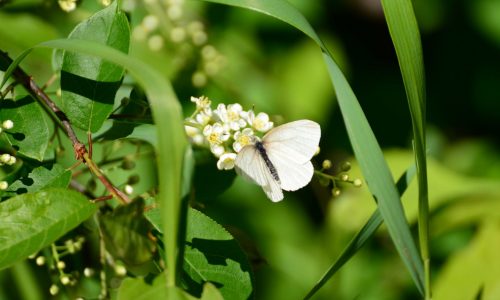
The West Virginia White (Pieris virginiensis) is a small white-translucent butterfly in the family of Pieridae. It is found in Quebec, southern Ontario and is known to commonly habituate certain areas in the United States. In actuality, there are only about 50 sites in Ontario where the butterfly has been spotted; the largest populations are near Lake Ontario. In Canada, the status of the butterfly has been listed as Not at Risk (COSEWIC 2000). Provincially, the government of Ontario has listed the species as Special Concern on the the Endangered Species Act. This means that the population of this butterfly will be monitored in Ontario, as it is at risk of becoming threatened if action is not taken to reverse current threats.
West Virginia White habitats are characterized by moist, deciduous forests which contain a large amount of two-leaved toothwort (Cardamine diphylla), its larval foodplant (MECP, 2019). It is an early-flying spring species, most commonly encountered in April and May (MECP 2019). Females will lay single eggs on the leaves of toothwort and adults are no longer flying by June. After hatching, caterpillars feed for 10-20 days before pupating. They stay in their pupa through the summer and winter before emerging the following spring (MECP 2019).
The greatest threats to this species are the further destruction and fragmentation of its habitats, loss of its primarily food source (due to deer grazing and other land disturbance) and climate change events (Davis and Cipollini 2016).
Given the rarity of this butterfly in Ontario, the province has developed a management plan to ensure that the local population thrives. The West Virginia White Management Plan strives to determine the size of the known population (survey for new ones), monitor these groups, maintain/conserve the butterfly habitat, and evaluate the risk status of the species both federally and provincially (MECP 2019).
